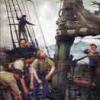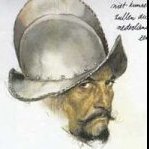-
Posts
1,553 -
Joined
-
Last visited
Reputation Activity
-
 G.L. got a reaction from tarbrush in Oostends schipje by G.L. - scale 1:20 - Ostend shrimper - first POF - Edition 2
G.L. got a reaction from tarbrush in Oostends schipje by G.L. - scale 1:20 - Ostend shrimper - first POF - Edition 2
12.8
The top side of the cabin entrance can now be covered with planks. I glue a strip of black card board between the planks because I presume the roof was caulked. In the roof the opening for entering is left uncovered.
-
 G.L. got a reaction from John Allen in Oostends schipje by G.L. - scale 1:20 - Ostend shrimper - first POF - Edition 2
G.L. got a reaction from John Allen in Oostends schipje by G.L. - scale 1:20 - Ostend shrimper - first POF - Edition 2
12.7
I glue the bottom-, top front- and top middle beam between the 2 sides and fill the so formed front frame with planks. The width of both top beams was almost double as it should be. When the glue was dry, I sanded the topside of the deckhouse arched with the band sander as can be seen on the picture.
-
 G.L. got a reaction from mtbediz in Oostends schipje by G.L. - scale 1:20 - Ostend shrimper - first POF - Edition 2
G.L. got a reaction from mtbediz in Oostends schipje by G.L. - scale 1:20 - Ostend shrimper - first POF - Edition 2
12.6
I start to make the frames of both sides of the deckhouse. Afterwards I fill the inside of the frames with planks.
-
 G.L. got a reaction from tarbrush in Oostends schipje by G.L. - scale 1:20 - Ostend shrimper - first POF - Edition 2
G.L. got a reaction from tarbrush in Oostends schipje by G.L. - scale 1:20 - Ostend shrimper - first POF - Edition 2
12.5
Just behind the chimney is the cabin entrance. It has a gliding hatch and double door. I would like to make a functioning hatch and doors.
-
 G.L. got a reaction from KORTES in Oostends schipje by G.L. - scale 1:20 - Ostend shrimper - first POF - Edition 2
G.L. got a reaction from KORTES in Oostends schipje by G.L. - scale 1:20 - Ostend shrimper - first POF - Edition 2
12.4
Here it is assembled and standing into position. Before it will be placed permanently it has to be blackened.
-
 G.L. got a reaction from mtbediz in Oostends schipje by G.L. - scale 1:20 - Ostend shrimper - first POF - Edition 2
G.L. got a reaction from mtbediz in Oostends schipje by G.L. - scale 1:20 - Ostend shrimper - first POF - Edition 2
12.3
As there is a stove in the crew shelter, there has to be a chimney. I make it of a 5mm brass tube sawn under 45° and soldered together. It stands on a small brass ring, sawn and filed out of a brass plate.
-
 G.L. got a reaction from mtbediz in Oostends schipje by G.L. - scale 1:20 - Ostend shrimper - first POF - Edition 2
G.L. got a reaction from mtbediz in Oostends schipje by G.L. - scale 1:20 - Ostend shrimper - first POF - Edition 2
12.2
I add also the a small rail with 3 holes for belaying pins, connecting the jib boom support with the knight head.
The belaying pins are made on the lathe of a spar of beech.
1. I first cut the thin part of the pin.
2. With a round file I shape the body of the handle.
3. I then cut off the pin from the spar and turn it around with the thin part in the chuck and I round the upper side of the handle with a flat (triangle) file.
4. The result.
5. The pins in the rail.
-
 G.L. got a reaction from mtbediz in Oostends schipje by G.L. - scale 1:20 - Ostend shrimper - first POF - Edition 2
G.L. got a reaction from mtbediz in Oostends schipje by G.L. - scale 1:20 - Ostend shrimper - first POF - Edition 2
Part 12: Making deck gear
12.1
Now the deck is laid, I can finish the jib boom support with props on the deck.
-
 G.L. got a reaction from Pete38 in HMS Triton cross section - FINISHED - by G.L. Scale 1:24
G.L. got a reaction from Pete38 in HMS Triton cross section - FINISHED - by G.L. Scale 1:24
The hatches into their position on the cross section.
-
 G.L. got a reaction from Mirabell61 in Oostends schipje by G.L. - scale 1:20 - Ostend shrimper - first POF - Edition 2
G.L. got a reaction from Mirabell61 in Oostends schipje by G.L. - scale 1:20 - Ostend shrimper - first POF - Edition 2
12.24
I finish the hatch with sanding it and adding corner-claps to the corners.
-
 G.L. got a reaction from mtbediz in Oostends schipje by G.L. - scale 1:20 - Ostend shrimper - first POF - Edition 2
G.L. got a reaction from mtbediz in Oostends schipje by G.L. - scale 1:20 - Ostend shrimper - first POF - Edition 2
12.23
Planking the hatch. Again with black cardboard strips between the planks.
-
 G.L. got a reaction from mtbediz in Oostends schipje by G.L. - scale 1:20 - Ostend shrimper - first POF - Edition 2
G.L. got a reaction from mtbediz in Oostends schipje by G.L. - scale 1:20 - Ostend shrimper - first POF - Edition 2
12.22
The frame of the hatch in place on the hatchway.
-
 G.L. got a reaction from tarbrush in Oostends schipje by G.L. - scale 1:20 - Ostend shrimper - first POF - Edition 2
G.L. got a reaction from tarbrush in Oostends schipje by G.L. - scale 1:20 - Ostend shrimper - first POF - Edition 2
12.20
The fish hold is covered by a hatch. In the pictures below you see the subsequent stages of the construction of the hatch-coamings. I believe they are self explaining.
-
 G.L. got a reaction from Derek C in HMS Triton Cross Section by Derek C - FINISHED
G.L. got a reaction from Derek C in HMS Triton Cross Section by Derek C - FINISHED
Derek,
It looks impeccable. Nice joinery!
G.L.
-
 G.L. got a reaction from mtaylor in HMS Triton Cross Section by Derek C - FINISHED
G.L. got a reaction from mtaylor in HMS Triton Cross Section by Derek C - FINISHED
Derek,
It looks impeccable. Nice joinery!
G.L.
-
 G.L. got a reaction from tarbrush in Oostends schipje by G.L. - scale 1:20 - Ostend shrimper - first POF - Edition 2
G.L. got a reaction from tarbrush in Oostends schipje by G.L. - scale 1:20 - Ostend shrimper - first POF - Edition 2
12.24
I finish the hatch with sanding it and adding corner-claps to the corners.
-
 G.L. got a reaction from mtbediz in Oostends schipje by G.L. - scale 1:20 - Ostend shrimper - first POF - Edition 2
G.L. got a reaction from mtbediz in Oostends schipje by G.L. - scale 1:20 - Ostend shrimper - first POF - Edition 2
11.7
The deck is finished with tree nails and then sanding, sanding and sanding...
-
 G.L. got a reaction from mtaylor in Oostends schipje by G.L. - scale 1:20 - Ostend shrimper - first POF - Edition 2
G.L. got a reaction from mtaylor in Oostends schipje by G.L. - scale 1:20 - Ostend shrimper - first POF - Edition 2
12.24
I finish the hatch with sanding it and adding corner-claps to the corners.
-
 G.L. reacted to Derek C in HMS Triton Cross Section by Derek C - FINISHED
G.L. reacted to Derek C in HMS Triton Cross Section by Derek C - FINISHED
I am slowly making progress on the lower deck cutting and notching each piece as I go I should be adding planks soon .o will be using a nice white aspen for the planking.
Thanks for looking in
Derek
-
 G.L. reacted to Cathead in Arabia 1856 by Cathead - FINISHED - Scale 1:64 - sidewheel riverboat from the Missouri River, USA
G.L. reacted to Cathead in Arabia 1856 by Cathead - FINISHED - Scale 1:64 - sidewheel riverboat from the Missouri River, USA
I've begun planking the hull, and immediately encountered a problem; I would love some advice. As I run the planking toward the stern, the natural lie of the planking really diverges from the line of the decking/guards. You can see what I mean here:
If I try to run the upper plank flush to the underside of the guards all the way, it takes some major edge-bending, more than I suspect the builders would have done. Moreover, the effect multiplies as you go down and just doesn't work. Although the stern here superficially resembles that of a sailing ship, it's narrowing in far more, so the curves involved are really tight. My photos of the original stern fragment sure make it look like the planks ran parallel to the guards, but that isn't working for the geometry of my hull:
Granted, the real fragment is very short so there may well have been any number of drop planks or something that I don't know about. In order to let the planking run smoothly on my hull, I'm going to have to drop the first two strakes and let the third one reach the actual stern (as shown above). But I have no idea whether this was a practice, or really much else about steamboat planking, as no sources I've read really deal with this question.
It's also interesting that, on the real stern, the first few planks were relatively wide, followed by a bunch of tapered planks. This makes sense overall, but again I can't figure out how those wide upper planks are supposed to wrap around such a tight curve without extraordinary edge bending. If I were planking this without the visual references, I'd be tapering things from the start, but I was hoping to match (at least somewhat) what I saw in the real stern, which means a few wider planks first.
Does my question make sense? Any thoughts?
-
 G.L. reacted to vaddoc in Deben 5-tonner by vaddoc - FINISHED - Scale 1:10 - a Whisstock yard design
G.L. reacted to vaddoc in Deben 5-tonner by vaddoc - FINISHED - Scale 1:10 - a Whisstock yard design
Another milestone reached, the hull is finished!
It took a massive amount of filler to do the job.
Then I applied two coats of sanding sealer, sanding after its coat. Finally, I sanded to 240 grit and then used some 0000 steel wool. The hull is now very smooth, sealed and the imperfections are all filled. Notice that the light reflects off the surface of the hull!
I then cut the ribs flush with the sheer. I left the ones that secure the braces though. I now need to figure out how the deck will work and then start making the beams
.
-
 G.L. got a reaction from tadheus in Oostends schipje by G.L. - scale 1:20 - Ostend shrimper - first POF - Edition 2
G.L. got a reaction from tadheus in Oostends schipje by G.L. - scale 1:20 - Ostend shrimper - first POF - Edition 2
12.16
Cabin entrance set into its spot. I do not glue it yet, I want to wait until all the deck gear is colored. It is located a bit right of mid ship to allow to pull the jib boom backwards.
-
 G.L. got a reaction from John Allen in Oostends schipje by G.L. - scale 1:20 - Ostend shrimper - first POF - Edition 2
G.L. got a reaction from John Allen in Oostends schipje by G.L. - scale 1:20 - Ostend shrimper - first POF - Edition 2
12.15
Doors and hatch open.
-
 G.L. got a reaction from tarbrush in Oostends schipje by G.L. - scale 1:20 - Ostend shrimper - first POF - Edition 2
G.L. got a reaction from tarbrush in Oostends schipje by G.L. - scale 1:20 - Ostend shrimper - first POF - Edition 2
12.14
Doors and hatch closed.
-
 G.L. got a reaction from mtaylor in Oostends schipje by G.L. - scale 1:20 - Ostend shrimper - first POF - Edition 2
G.L. got a reaction from mtaylor in Oostends schipje by G.L. - scale 1:20 - Ostend shrimper - first POF - Edition 2
12.13
I finish the hinges by filing them.











